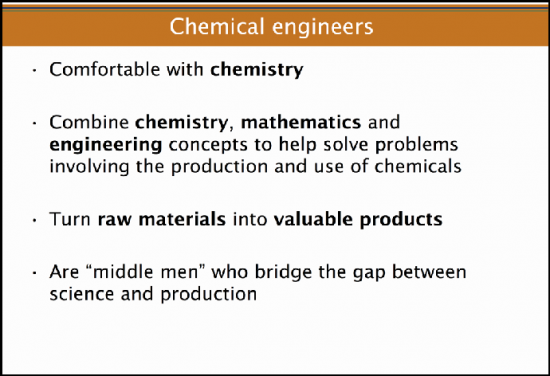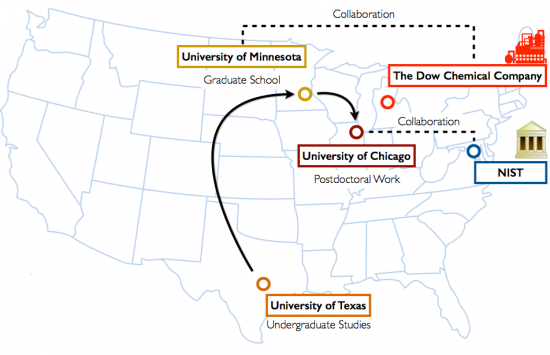AIChE will undertake a routine upgrade of our digital infrastructure between 12AM to 6AM ET on Tuesday April 22. During this time access to all services that require login or payment will be unavailable.
Building Bridges in Academic Research for Successful Partnerships
by Dr. Jeffrey M. Ting
NIST-CHiMaD Postdoctoral Fellow at the University of Chicago Institute for Molecular Engineering
In my Introduction to chemical engineering on the first day at the University of Texas, Dr. Roger Bonnecaze and Dr. Kelly McQueary challenged our freshmen class with a simple question: “What is a chemical engineer?”
Although this is a straightforward enough question, I found myself unable to give a precise answer. Figure 1 shows some definitions from the presentation that students have given throughout the years. But more broadly – and especially in modern times – Dr. Bonnecaze argued that chemical engineers are universal engineers: practical, adaptable problem solvers uniquely positioned with knowledge of chemistry, mathematics, and engineering to define systems by mass and energy balances. Because of this versatility, chemical engineers often take on the role of bridging gaps between science and production to address unsolved needs in important energy, biomedical, and environmental applications.1

Figure 1. Various responses to what a chemical engineer can be defined as, from various undergraduate chemical engineering students.
In the higher education landscape, chemical engineers can facilitate key contributions toward establishing relationships between disciplines. For instance, Neal Amundson recognized the importance of predictive mathematical modeling for rigorously describing complex system processes in industrially relevant chemical applications.2 This focus on addressing practical problems with fundamental knowledge often aids in the translation of ideas into technologies. However, while collaboration skills are often not explicitly taught in a classroom, studies have demonstrated their value and importance in career development.3 In graduate school, where innovative research reside on the forefront of current scientific capabilities, healthy working relationships with collaborators at industry and government sectors can launch the progression of a benchtop discovery into an impactful product to society.
This article offers insight from my personal experiences for building camaraderie and success in academic research settings. Figure 2 shows my academic journey so far. My graduate work at the University of Minnesota was supported by The Dow Chemical Company, and my current postdoctoral fellowship is supported by the NIST Center for Hierarchical Materials Design. Each unique opportunity presented distinct advantages and challenges. Select examples of my research endeavors4,5 focus on balancing the needs of my doctoral/post-doctoral work and the project goals of my collaborators. I have organized my thoughts into three main points that I have learned during my professional training to overcome key barriers for effective partnerships.

Fig. 2. Schematic of my academic journey comprising my undergraduate studies, graduate school, and postdoctoral work. Collaborations with industry and governmental laboratories are shown.
Provide sincere appreciation and honest feedback. In the academic world, this is equivalent to providing praise in the Acknowledgements section of a scientific manuscript. This simple piece of advice often appears in various forms across self-improvement resources. If interested, my personal recommendation is “How to Win Friends and Influence People” by Dale Carnegie,6 which was assigned as a reading resource in the Introduction to Chemical Engineering course mentioned above. For me, the lessons detailed by each chapter shaped how I interacted with classmates in undergraduate and graduate school while working on coursework and group assignments.
My graduate research required monthly video meetings with our industrial colleagues, which facilitated routine preparation of collected data and feedback. Although it was daunting at first, the discussions provided invaluable direction in exploring this new area of research for our research groups at the University of Minnesota. In this collegial atmosphere, ideas were openly shared, formulated, and often reformulated. Listening earnestly built the framework for mutual trust, enthusiasm, and respect between individuals.
Align goals and project milestones. Research goals and project milestones are often important aspects of graduate school. Outlining expectations early on during the formation of a new collaboration can considerably reduce the possibilities of future conflict, especially in the face of imminent deadlines or unexpected obstacles. Agreeing to common goals can serve as positive motivators for progressing experiments, analysis, and discussions in a satisfactory amount of time.
Every year, I write out short- and long-term goals on paper. From a mentor perspective, I often imagine these goals as lighthouses to help navigate day-to-day life as a researcher. In this analogy, these beacons are fluid: they can change in scope but always provide a common goal to work towards. I have found this strategy to be useful to help establish shared aims among collaborators in a team.
Be proactive in initiating discussions. Intellectual collaborations between academic institutions and industrial or governmental partners can diversify the number of successful outcomes. Both of my research project’s financial supporters described the critical needs that could broadly impact society, while conducting academic research offered the possibility to discover breakthroughs that may preclude R&D at the industrial level. Under these circumstances, seeking out this information from all stakeholders in a proactive manner facilitated a positive working relationship. In other words, my final piece of advice is to take on the leadership role in managing collaborations, even as a new student.
Altogether, successful collaborations between academic researchers and industrial/governmental agencies need practical mechanisms in place to promote cooperation and mutual interest. The three main points above have proven useful for my own professional career and development. Strong cross-disciplinary collaborations, balancing the expertise, support, and needs of individuals and agencies, can foster team-driven creativity and innovation in the advancement of basic research into technological achievements.
References
(1) Banholzer, W. F.; Jones, M. E. Chemical Engineers Must Focus on Practical Solutions. AIChE J. 2013, 59, 2708–2720.
(2) Bates, F. S. Neal R. Amundson, a Bold and Brilliant Leader of Chemical Engineering. Proc. Natl. Acad. Sci. USA 2011, 108, 7285–7285.
(3) Grant, C. D.; Dickson, B. R. Personal Skills in Chemical Engineering Graduates. Educ. Chem. Eng. 2006, 1, 23–29.
(4) Ting, J. M.; Tale, S.; Purchel, A. A.; Jones, S. D.; Widanapathirana, L.; Tolstyka, Z. P.; Guo, L.; Guillaudeu, S. J.; Bates, F. S.; Reineke, T. M. High-Throughput Excipient Discovery Enables Oral Delivery of Poorly Soluble Pharmaceuticals. ACS Cent. Sci. 2016, 2, 748–755.
(5) Ting, J. M.; Wu, H.; Herzog-Arbeitman, A.; Srivastava, S.; Tirrell, M. V. Synthesis and Assembly of Designer Styrenic Diblock Polyelectrolytes. ACS Macro Lett. 2018, 726–733.
(6) Carnegie, D. How to Win Friends and Influence People; Simon and Schuster, 1936.
- Log in to post comments
